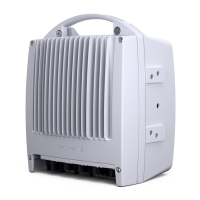MINI-LINKEandEMicro
3.8.2.2 2/8 Mbit/s Multiplexer/Demultiplexer (MMU 4x2/8 only)
The 4x2 Mbit/s multiplexing and demultiplexing conforms to ITU-T Rec G.703
and G.742.
In the multiplex direction, the four input 2 Mbit/s baseband signals are received
and decoded. The incoming timing information is extracted and the traffic
infor m ation is read into a buffer memory.
The buffer memory loading ratio is controlled by positive justification. The four
synchronized signals are subsequently multiplexed together with a justificati on
indicator and framing information bits into the 8 Mbit/s signal.
In the demultiplex direction, frame alignment is made and the four tributary
signals are sent to buffer memories after the framing, stuff indicator and
redundant bits have been removed. The cr ystal-controlled read-out rate from
the buffer memory is then filtered to reduce output jitter. Finally the signal is
line-coded and transmitted.
3.8.2.3 Radio Frame Multiplexer and Forward Error Correction (FEC)
Three different data types are multiplexed into the data stream to be transmitted
over the radio path:
•Traffic
• Ser vice channel
• Hop Communication Channel (HCC)
Transmit Traffic Data
The transmit traffic data is f irst sent to the multiplexer to assure data rate
adaptation (stuffing). If no valid data is present at the input, an AIS signal is
inser ted at nominal data rate. This means that the data traff ic across the hop is
replaced with ones (1).
Transmit Ser vice Data Channel
Two independent service channels are provided. Analog and digital service
data are handled differently. Clock and sync pulses are sent to the SAU and
data from the SAU is fed to the multiplexer. In digital mode data and byte sync
pulses are fed to an elastic store before data is read out in synchronism with
the composite clock. Appropriate stuffing signals are generated to enable data
rate transparency.
Hop Communication Channel
The Hop Communication Channel (HCC) is used for exchange of control and
super vision information between near-end and far-end MMUs.
47
AE/LZT 110 2012 R8C 2002- 03-04

